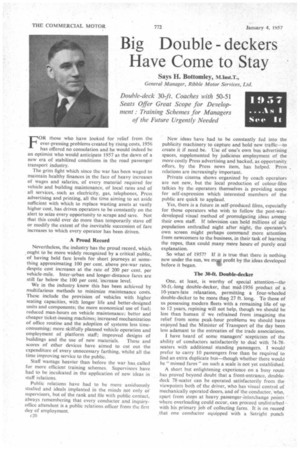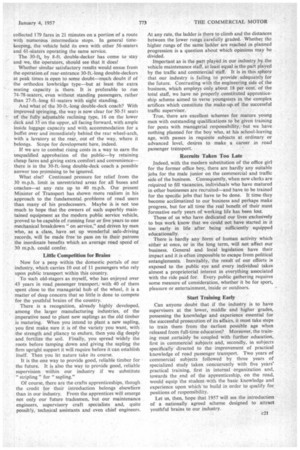Big Double deckers Have Come to Stay
Page 60

Page 61

If you've noticed an error in this article please click here to report it so we can fix it.
Says H. Bottomley,
FOR those who have looked for relief from the ever-pressing problems created by rising costs, 1956 has offered no consolation and he would indeed be an optimist who would anticipate 1957 as the dawn of a new era of stabilized conditions in the road passenger transport industry.
The grim fight which since the war has been waged to maintain healthy finances in the face of heavy increases of wages and salaries, of every material required for vehicle and building maintenance, of local rates and of all services, such as electricity, gas, telephones, Press advertising and printing, all the time aiming to set aside sufficient with which to replace wasting assets at vastly higher cost, has driven operators to be constantly on the alert to seize every opportunity to scrape and save. Not that this could ever do more than temporarily stave off or modify the extent of the inevitable succession of fare increases to which every operator has been driven.
A Proud Record
Nevertheless, the industry has the proud record, which ought to be more widely recognized by a critical public, of having held fare levels for short journeys at something approximating 100 per cent, above pre-war rates, despite cost increases at the rate of 200 per cent. per vehicle-mile. Inter-urban and longer-distance fares are still far below the 100 per cent, increase level.
We in the industry know this has been achieved by multifarious methods to minimize maintenance costs. These include the provision of vehicles with higher seating capacities, with longer life and better-designed units and components; the more economical use of fuel; reduced man-hours on vehicle maintenance; better and cheaper ticket-issuing machines; increased mechanization of office routine and the adoption of systems less timeconsuming; more skilfully planned vehicle operation and employment of platform staff; improved designs of buildings and the use of new materials. These and scores of other devices have aimed to cut out the expenditure of every unnecessary farthing, whilst all the time improving service to the public.
Staff wastage heavier than before the war has called for more efficient training schemes. Supervisors have had to be inculcated in the application of new ideas in staff relations.
Public relations have had to be more assiduously studied and ideals implanted in the minds not only of supervisors, but of the rank and file with public contact, always remembering that every conductor and inquiryoffice attendant is a public relations officer from the first day of employment.
c20 New ideas have had to be constantly fed into the publicity machinery to capture and hold new traffic—to create it if need be. Use of one's own bus advertising spaces, supplemented by judicious employment of the more costly Press advertising and backed, as opportunity offers, by the Press news item, has helped. Press relations are increasingly important.
Private cinema shows organized by coach operators are not new, but the local production of colour-film talkies by the operators themselves is providing scope for self-expression which interested members of the public are quick to applaud.
Yes, there is a future in self-produced films, especially for those operators who wish to follow the post-wardeveloped visual method of promulgating ideas among their own staff. If television can hold millions of obr population enthralled night after night, the operator's own screen might perhaps command more attention from newcomers to the business, in their task of learning the ropes, than could many more hoursof purely oral explanation.
So what of 19577 If it is true that there is nothing new under the sun, we mt profit by the ideas developed before it began.
The 30-ft. Double-decker
One, at least, is worthy of special attention—the 30-ft.-Iong double-decker, that mid-1956 product of a 10-years-late relaxation, permitting a four-wheeled double-decker to be more than 27 ft. long. To those of us possessing modern fleets with a remaining life of up to 12 years, repining will not help, though we should be less than human if we refrained from imagining the relief from some peak-hour problems we should have enjoyed had the Minister of Transport of the day been less adamant to the entreaties of the trade associations.
I have heard of some managers' scepticism of the ability of conductors satisfactorily to deal with 74-78seaters with additional standing passengers. I would prefer to carry 10 passengers free than be required to find an extra duplicate bus—though whether there would be "missed fares" on such a scale is not yet established.
A short but enlightening experience on a busy route has proved beyond doubt that a front-entrance, doubledeck 78-seater can be operated satisfactorily from the viewpoints both of the driver, who has visual control of mechanically operated doors, and of the conductor, who, apart from stops at heavy passenger-interchange points where overloading could occur, can proceed undisturbed with his primary job of collecting fares. It is on record that one conductor equipped with a Setright punch
collected 179 fares in 21 minutes on a portion of a route with numerous intermediate stops. In general timekeeping, the vehicle held its own with other 56-seaters and 61-staters operating the same service.
The 30-ft., by 8-ft. double-decker has come to stay and we, the operators, should see that it does!
Whether similar satisfactory results would ensue from the operation of rear-entrance 30-ft-long double-deckers at peak times is open to some doubt—much doubt if of the orthodox lowbridge type—but at least the extra seating capacity is there. It is preferable to run 74-78-seaters, even without standing passengers, rather than 27-ft.-long 61-seaters with eight standing.
And what of the 30-ft.-long double-deck coach? With improved springing, the way is now clear for 50-51 seats of the fully adjustable reclining type, 16 on the lower deck and 35 on the upper, all facing forward, with ample inside luggage capacity and with accommodation for a buffet over and immediately behind the rear wheel-arch, with a lavatory at the rear, out of the way, where it belongs. Scope for development here, indeed.
If we are to combat rising costs in a way to earn the unqualified approbation of the public—by retaining cheap fares and giving extra comfort and convenience— there is in the 30-ft.-long double-deck coach a possible answer too promising to be ignored.
What else? Continued pressure for relief from the 30 m.p.h. limit in unrestricted areas for all buses and coaches—at any rate up to 40 m.p.h. Our present Minister of Transport has shown more realism in his approach to the fundamental problems of road users than many of his predecessors. Maybe it. is not too much to hope that the owners of such superbly maintained equipment as the modern public service vehicle, proved to be capable of running four or five years to one mechanical breakdown "on service," and driven by men who, as a class, have set up wonderful safe-driving records, will be made free to pass on to their patrons the inordinate benefits which an average road speed of 30 m.p.h. could confer.
Little Competition for Brains
Now for a peep within the domestic portals of our industry, which carries 10 out of 11 passengers who rely upon public transport within this country.
To such old-stagers as myself, who has enjoyed over 43 years in road passenger transport, with 40 of them spent close to the managerial hub of the wheel, it is a matter of deep concern that so little is done to compete for the youthful brains of the country.
There is a recognition, already highly developed, among the larger manufacturing industries, of the imperative need to plant new saplings as the old timber is maturing. When you intend to plant a new sapling, you first make sure it is of the variety you want, with the strength and pliancy to endure, then you dig deeply and fertilize the soil. Finally, you spread widely the roots before tamping down and giving the sapling the firm upright support it will require before it can establish itself. Then you let nature take its course.
It is the one way to provide good, reliable timber for the future. It is also the way to provide good, reliable supervision within our industry if we substitute " stripling " for " sapling."
Of course, there are the crafts apprenticeships, though the credit for their introduction belongs elsewhere than in our industry. From the apprentices will emerge not only our future tradesmen, but our maintenance engineers, supervisory craft specialists and, quite possibly, technical assistants and even chief engineers. At any rate, the ladder is there to climb and the distances between the lower rungs carefully graded. Whether du: higher rungs of the same ladder are reached in planned progression is a question about which opinions may be divided.
Important as is the part played in our industry by the vehicle maintenance staff, at least equal is the part played by the traffic and commercial staff. It is in this sphere that our industry is failing to provide adequately for the future. Contrasting with the engineering side of the business, which employs only about 18 per cent, of the total staff, we have no properly constituted apprenticeship scheme aimed to verse youngsters in the complex artifices which constitute the make-up, of the successful traffic supervisor.
True, there are excellent schemes for mature young men with outstanding qualifications to be given training for posts with managerial responsibility, but we have nothing planned for the boy who, at his school-leaving age, with passes in requisite subjects at ordinary or advanced level, desires to make a career in road passenger transport.
Recruits Taken Too Late
Indeed, with the modern substitution of the office girl for the former office boy, there are hardly any suitable jobs for the male junior on the commercial and traffic side of the business. Consequently, when new clerks are required to fill vacancies, individuals who have matured in other businesses are recruited—and have to be trained for the specific jobs that have to be done. It time they become acclimatized to our business and perhaps make progress, but for all time the real benefit of their most formative early years of working life has been lost.
Those of us who have dedicated our lives exclusively to bus work know that we could not have started in it too early in life after being sufficiently equipped educationally.
There is hardly any form of human activity which either at once, or in the long term, will not affect our business. General and local legislation have their impact and it is often impossible to escape from political entanglements. Inevitably, the result of our efforts is exposed to the public eye and every individual takes almost a proprietorial interest in everything associated with the ride paid for. Every public gathering requires some measure of consideration, whether it be for sport, pleasure or entertainment, inside or outdoors.
Start Training Early
Can anyone doubt that if the industry is to have supervisors at the lower, middle and higher grades, possessing the knowledge and experience essential for the successful prosecution of its affairs, it must take steps to train them from the earliest possible age when released from full-time education? Moreover, the training must certainly be coupled with further education, first in commercial subjects and, secondly, in subjects specifically directed to the improvement of practical knowledge of road passenger transport. Two years of commercial subjects followed by three years of specialized study taken concurrently with five years' practical training, first in internal organization and, towards the _end of the apprenticeship, on the road, would equip the student-with the basic knowledge and experience upon which to build in order to qualify for positions of responsibility.
Let us, then, hope that 1957 will see the introduction of a nationally agreed scheme designed to attract youthful brains to our industry.








































































































